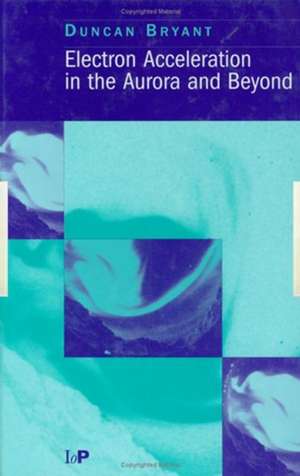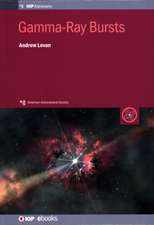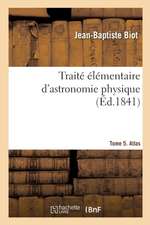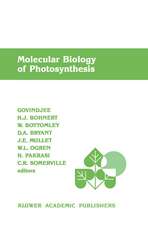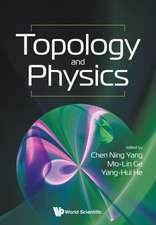Electron Acceleration in the Aurora and Beyond
Autor D Bryanten Limba Engleză Hardback – oct 1998
‘Electron Acceleration in the Aurora and Beyond’ explores this and other mysteries concerning the acceleration of electrons in the Earth’s magnetosphere, in the solar wind, at the Sun, at an ‘artificial comet’, and in the Cosmos. The author has had first-hand experience of exploring all of these areas and has pioneered the transition, which now seems to be complete, from the static to the dynamic theory of acceleration. He writes in a conversational style, inviting the reader into the discussion which ranges from the motion of charged particles in electromagnetic fields to the statistical mechanics of interactions between plasma waves and charged particles.
The book is copiously illustrated with more than 170 figures and colour plates. Questions, exercises, and computer programs are provided to stimulate further thinking.
‘This is an absolute jewel of an introduction to the subject.’ Journal of Plasma Physics
‘His book is an excellent starting point for those about to embark on studies in space science.’ The Observatory
‘…the community should thank him for having written it.’ Eos, Transactions of the American Geophysical Union.
Preț: 1464.99 lei
Preț vechi: 1972.29 lei
-26% Nou
Puncte Express: 2197
Preț estimativ în valută:
280.36€ • 289.63$ • 233.33£
280.36€ • 289.63$ • 233.33£
Carte tipărită la comandă
Livrare economică 26 martie-09 aprilie
Preluare comenzi: 021 569.72.76
Specificații
ISBN-13: 9780750305334
ISBN-10: 0750305339
Pagini: 340
Ilustrații: 1 b/w image
Dimensiuni: 156 x 234 x 24 mm
Greutate: 0.73 kg
Ediția:1
Editura: CRC Press
Colecția CRC Press
ISBN-10: 0750305339
Pagini: 340
Ilustrații: 1 b/w image
Dimensiuni: 156 x 234 x 24 mm
Greutate: 0.73 kg
Ediția:1
Editura: CRC Press
Colecția CRC Press
Public țintă
ProfessionalCuprins
Accelerator principles. The arena. Electron acceleration in the Aurora. Electron acceleration at the Earth's bow shock Electron acceleration in the neighbourhood of artificial comets. Electron acceleration in solar wind events. Electron acceleration at the terrestrial magnetopause. Electron acceleration in the Earth's magnetosphere. Electron acceleration at the Sun. Electron acceleration in the Cosmos. Reflections
Recenzii
Here are some selections from the excellent reviews which appeared in scientific journals in the areas of geophysics, space physics, plasma physics and astronomy.
"This is a delightful book. The first chapter alone provides the reader with quite a good conceptual grasp of classical mechanics as it applies to space plasma research. Bryant has taken good advantage of the present opportunity to put his concept of auroral electron acceleration firmly on record, and I think the community will benefit from seeing his thoughts on this matter systematically expressed. I recommend the book highly. I think it is instructive, informative, and (of course) provocative. ....the community should thank him for having written it.."
Eos, Transactions of the American Geophysical Union.
"[The book] is to be recommended to anyone interested in electron acceleration anywhere between himself and the sun. The first chapter can be enjoyed by almost any classical physicist."
Journal of Plasma Physics
"This book has a very welcome 'hands-on' approach.....Bryant makes the reader think more seriously about wave-particle interactions as a primary acceleration mechanism. His book is an excellent starting point for those about to embark on studies of space science."
The Observatory
"There is much here to consider -- particularly for researchers involved in the field."
Astronomy Now
"The author makes a persuasive case that acceleration in the aurora, and in other plasma environments accessible to in situ measurements, involves some form of wave turbulence."
Nuclear Fusion
"This is a delightful book, in which the author uses mainly words and diagrams to provide clear explanations of a large variety of space plasma topics ... I recommend this book highly. I think it is instructive, informative, and (of course) provocative ... Duncan Bryants books reveals many valuable insights, and the community should thank him for having written it."
Michael Schulz, space Physics Department, Lockheed Martin Advanced Technology Center, Palo Alto
in EOS, the newspaper of the Geophysical Sciences
"...there is much here to consider - particularly for researchers involved in the field ... the author has taken great care to explain the underlying physics clearly and in detail."
".. the existence of such kind of book is very important".
Il Nuovo Cimento
e some selections from the excellent reviews which appeared in scientific journals in the areas of geophysics, space physics, plasma physics and astronomy.
"This is a delightful book. The first chapter alone provides the reader with quite a good conceptual grasp of classical mechanics as it applies to space plasma research. Bryant has taken good advantage of the present opportunity to put his concept of auroral electron acceleration firmly on record, and I think the community will benefit from seeing his thoughts on this matter systematically expressed. I recommend the book highly. I think it is instructive, informative, and (of course) provocative. ....the community should thank him for having written it.."
Eos, Transactions of the American Geophysical Union.
"[The book] is to be recommended to anyone interested in electron acceleration anywhere between himself and the sun. The first chapter can be enjoyed by almost any classical physicist."
Journal of Plasma Physics
"This book has a very welcome 'hands-on' approach.....Bryant makes the reader think more seriously about wave-particle interactions as a primary acceleration mechanism. His book is an excellent starting point for those about to embark on studies of space science."
The Observatory
"There is much here to consider -- particularly for researchers involved in the field."
Astronomy Now
"The author makes a persuasive case that acceleration in the aurora, and in other plasma environments accessible to in situ measurements, involves some form of wave turbulence."
Nuclear Fusion
"This is a delightful book, in which the author uses mainly words and diagrams to provide clear explanations of a large variety of space plasma topics ... I recommend this book highly. I think it is instructive, informative, and (of course) provocative ... Duncan Bryants books reveals many valuable insights, and the community should thank him for having written it."
Michael Schulz, space Physics Department, Lockheed Martin Advanced Technology Center, Palo Alto
in EOS, the newspaper of the Geophysical Sciences
"...there is much here to consider - particularly for researchers involved in the field ... the author has taken great care to explain the underlying physics clearly and in detail."
".. the existence of such kind of book is very important".
Il Nuovo Cimento
"This is a delightful book. The first chapter alone provides the reader with quite a good conceptual grasp of classical mechanics as it applies to space plasma research. Bryant has taken good advantage of the present opportunity to put his concept of auroral electron acceleration firmly on record, and I think the community will benefit from seeing his thoughts on this matter systematically expressed. I recommend the book highly. I think it is instructive, informative, and (of course) provocative. ....the community should thank him for having written it.."
Eos, Transactions of the American Geophysical Union.
"[The book] is to be recommended to anyone interested in electron acceleration anywhere between himself and the sun. The first chapter can be enjoyed by almost any classical physicist."
Journal of Plasma Physics
"This book has a very welcome 'hands-on' approach.....Bryant makes the reader think more seriously about wave-particle interactions as a primary acceleration mechanism. His book is an excellent starting point for those about to embark on studies of space science."
The Observatory
"There is much here to consider -- particularly for researchers involved in the field."
Astronomy Now
"The author makes a persuasive case that acceleration in the aurora, and in other plasma environments accessible to in situ measurements, involves some form of wave turbulence."
Nuclear Fusion
"This is a delightful book, in which the author uses mainly words and diagrams to provide clear explanations of a large variety of space plasma topics ... I recommend this book highly. I think it is instructive, informative, and (of course) provocative ... Duncan Bryants books reveals many valuable insights, and the community should thank him for having written it."
Michael Schulz, space Physics Department, Lockheed Martin Advanced Technology Center, Palo Alto
in EOS, the newspaper of the Geophysical Sciences
"...there is much here to consider - particularly for researchers involved in the field ... the author has taken great care to explain the underlying physics clearly and in detail."
".. the existence of such kind of book is very important".
Il Nuovo Cimento
e some selections from the excellent reviews which appeared in scientific journals in the areas of geophysics, space physics, plasma physics and astronomy.
"This is a delightful book. The first chapter alone provides the reader with quite a good conceptual grasp of classical mechanics as it applies to space plasma research. Bryant has taken good advantage of the present opportunity to put his concept of auroral electron acceleration firmly on record, and I think the community will benefit from seeing his thoughts on this matter systematically expressed. I recommend the book highly. I think it is instructive, informative, and (of course) provocative. ....the community should thank him for having written it.."
Eos, Transactions of the American Geophysical Union.
"[The book] is to be recommended to anyone interested in electron acceleration anywhere between himself and the sun. The first chapter can be enjoyed by almost any classical physicist."
Journal of Plasma Physics
"This book has a very welcome 'hands-on' approach.....Bryant makes the reader think more seriously about wave-particle interactions as a primary acceleration mechanism. His book is an excellent starting point for those about to embark on studies of space science."
The Observatory
"There is much here to consider -- particularly for researchers involved in the field."
Astronomy Now
"The author makes a persuasive case that acceleration in the aurora, and in other plasma environments accessible to in situ measurements, involves some form of wave turbulence."
Nuclear Fusion
"This is a delightful book, in which the author uses mainly words and diagrams to provide clear explanations of a large variety of space plasma topics ... I recommend this book highly. I think it is instructive, informative, and (of course) provocative ... Duncan Bryants books reveals many valuable insights, and the community should thank him for having written it."
Michael Schulz, space Physics Department, Lockheed Martin Advanced Technology Center, Palo Alto
in EOS, the newspaper of the Geophysical Sciences
"...there is much here to consider - particularly for researchers involved in the field ... the author has taken great care to explain the underlying physics clearly and in detail."
".. the existence of such kind of book is very important".
Il Nuovo Cimento
Descriere
How did electrons in the high atmosphere and space around the Earth come to acquire their speeds and energies?
This intriguing question lies at the heart of understanding how high-energy electrons create the spectacular displays of the Aurora Borealis and Aurora Australis. Electron Acceleration in the Aurora and Beyond explores the mysteries of these phenomena and others involving the acceleration of electrons in the magnetosphere, in the solar wind, at the Sun and in the Cosmos.
This book presents a new approach to understanding this fascinating subject by treating the acceleration medium as a plasma. Using this new insight we can see that electron acceleration may well be caused by waves rather than steady potential differences. This unique approach is clearly explained in a lively and engaging style.
Quantitative formulae, experiments, practical demonstrations and computer programs enable us to investigate for ourselves how the model works. The theory is further illustrated by comparing acceleration in space with particle accelerators in the nuclear physics laboratory (and even on the sports field!)
Questions and exercises with answers are supplied to stimulate further thinking.
^IElectron Acceleration in the Aurora and Beyond is a thought-provoking book for graduate and post-doctoral space scientists.
This intriguing question lies at the heart of understanding how high-energy electrons create the spectacular displays of the Aurora Borealis and Aurora Australis. Electron Acceleration in the Aurora and Beyond explores the mysteries of these phenomena and others involving the acceleration of electrons in the magnetosphere, in the solar wind, at the Sun and in the Cosmos.
This book presents a new approach to understanding this fascinating subject by treating the acceleration medium as a plasma. Using this new insight we can see that electron acceleration may well be caused by waves rather than steady potential differences. This unique approach is clearly explained in a lively and engaging style.
Quantitative formulae, experiments, practical demonstrations and computer programs enable us to investigate for ourselves how the model works. The theory is further illustrated by comparing acceleration in space with particle accelerators in the nuclear physics laboratory (and even on the sports field!)
Questions and exercises with answers are supplied to stimulate further thinking.
^IElectron Acceleration in the Aurora and Beyond is a thought-provoking book for graduate and post-doctoral space scientists.
